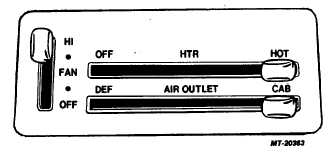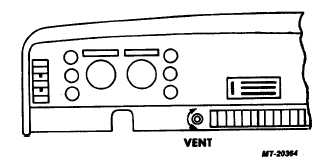|
| |
TRUCK SERVICE MANUAL
TM 5-4210-230-14&P-1
BODIES AND CABS
The refrigerant entering the evaporator expands and
begins to vaporize. Complete vaporization requires heat. The
refrigerant absorbs heat from the air surrounding the
evaporator coils and fins. As heat is absorbed the refrigerant
vaporizes.
The blower draws warm air from the cab and
circulates it past the evaporator where the heat is absorbed by
the refrigerant. Air exhausted by the blower is cool because
the heat has been removed.
From the evaporator, the refrigerant is drawn by
suction into the compressor. This completes the refrigerant
cycle which is repeated continuously until the temperature of
the cab interior is lowered to the desired temperature.
Cab interior temperature is controlled by the
thermostatic control switch. This control is adjustable to
permit the vehicle operator to select the temperature level
desired in the cab. The blower has a multi-speed control
which permits the vehicle operator to regulate the amount of
air circulation.
OPERATION
HEATING
For proper cold weather operation the heat should be
directed toward the floor level; therefore, close all instrument
panel outlets and fully open both floor dump outlets.
Adjust the temperature "HTR" (heat) lever as required
to give the desired degree of heat. The full right "HOT"
position provides the maximum heat. Move the "AIR
OUTLETS" control lever either to the full cab position or to
any of the other three detented positions in order to obtain the
desired air flow distribution between cab heat and defrost
requirements. For the maximum air flow, move the fan switch
to the "HI" position. The heater will also operate with the fan
motor in the "OFF" position due to the ram air introduced
during vehicle operation.
Fig. 19 Heater Controls Set for Maximum Heat
DEFROSTING
To obtain maximum defrosting, move the "HTR" lever
to the "HOT" position and place the "AIR OUTLETS" lever on
"DEF". Adjust the fan speed to provide the desired air flow.
To clear system of humid air, operate blowers for 30
seconds at "HI" speed before moving the "AIR OUTLETS"
lever to the "DEF" position. This will minimize rapid fogging of
glass, which can occur if humid air is blown onto a cool
windshield.
To improve defroster efficiency, remove ice and/or
snow from glass area.
Fig. 20 Heater Controls Set for Defrosting
FRESH AIR VENTILATION
Fresh
air
enters
the
cab
through
either
an
independent ventilation system or through the heater system
itself.
When the "VENT" knob is turned counterclockwise,
air enters the cab from the hood scoop and flows through the
instrument panel outlets and floor dumps. Except for the
ventilation mode, the knob should be rotated to its full
clockwise position (vent door closed) for all other modes of
operation.
To increase the quantity of air entering the cab in the
ventilation mode, the fan may be used to power ventilate.
Adjust the fan speed and air outlets for the desired air flow.
Fig. 21 Ventilator Control
CTS-2731 Page 13
PRINTED IN UNITED STATES OF AMERICA
|



